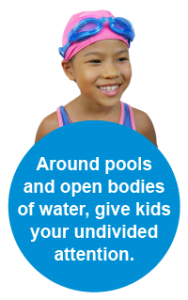Drowning Prevention & Swimming Safety
Nationally, drowning ranks second only to automobile crashes, claiming the lives of approximately 4,000 children each year and leaving another 12,000 with some form of permanent brain damage.
Drowning deaths increase up to 89% in the summer months. Help protect your children from these preventable tragedies. Learn the ABCs of drowning prevention. Your child’s life depends on it.
Click here for more information on swimming safety
Click here for our swimming safety tip sheet
ABC's of Drowning Prevention
A for Adult Supervision
- Adult supervision is key to drowning prevention. Always assign a “water watcher” who knows how to swim.
- Provide active adult supervision 100% of the time when children are in or near the water. Do not drink alcohol while supervising children.
- Children under 5 should be kept within arm’s reach while in water.
- Water wings, noodles, inner-tubes and life jackets should never take the place of adult supervision for children ages 0-5.
- Know where your children are at all times. 69% of children who drowned in swimming pools were not supposed to be in or around the water. If a child is missing, check the pool first.
B for Barriers
- Put in, check and always use a child-proof barrier around your pool/spa area.
- The only proven effective barrier is a 5 foot tall non-climbable fence with self-closing, self-latching gates that separates the pool from the house and yard.
- Remove toys from, in or around the pool area — they attract young children to the pool.
- Keep chairs, tables and other climbable items away from the
pool barrier.
C for CPR & Classes
- Learn CPR (Cardiopulmonary Resuscitation) and rescue breathing.
- Call 911. Start CPR and rescue breathing at pool side — this can save a life while the ambulance is on the way.
- Make sure all children and adults in your family go to swim lessons and water safety training. But remember these classes do not take the place of the need for adult supervision and barriers.
- To find swim classes ask at a local community pool, family resource center, or parks and recreation district locations.
- To find CPR classes contact your local Red Cross chapter, family resource center, or American Heart Association.
